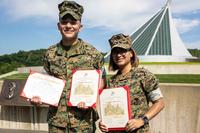After delays, hundreds of full-time Air Force reservists are preparing to join the Space Force this year, while the plan for their part-time colleagues is still in the works.
The transfers were directed by a 2024 law, that is phasing out space-focused positions in the reserve, including the entire 310th Space Wing, headquartered at Schriever Space Force Base. Most of the space-focused reservists in the country work for the wing and can choose to apply for the active duty, leave the reserve or retrain into a different reserve role.
The 310th Space Wing expects about 300 reservists will follow an initial five who have already transferred into active duty, said Col. Adam Fisher, wing commander. The wing only had 250 full-time members, so some part-time reservists were among those selected to go full-time, Fisher explained.
Since reservists applied and were accepted into active duty, the transfer process has been delayed, Fisher said, and it could be a challenge to see the reservists separated from the Air Force and transferred into the Space Force during the traditional summer move cycle.
“We were supposed to have started the assignment process months ago, but delays and, we’ll say, reframing of priorities from the Space Force have delayed the release of the assignments,” Fisher said
Last week, he said, the group planning to transfer was expected to receive job offers from the Space Force soon and those would include details such as their new squadron and title. Most of those roles will be focused on training, including roles in Space Training and Readiness Command, or STARCOM, based in Colorado Springs. Previously, some of those airmen worked alongside their active-duty counterparts working in missile warning or running GPS satellites.
While STARCOM headquarters is slated to move to Florida, some of the positions will remain local, he said.
Fisher said he expected the high level of experience among his reservists would be a good fit for training roles. Some will be classroom instructors, but others likely will move into positions such as testing new weapons and space systems or into replicating the threats that guardians could see in the field to help guardians train.
“Our individuals, I believe, will be well represented in Space Force,” he said.
The transfer of Air Force reservists is separate from the ongoing fight over whether space-focused Air National Guard units will transfer into active duty. While a law directed some of those units to transfer this year, state governors are pushing back on the plan, in part, because so many guardsmen plan to leave if they are forced to transfer.
In the reserve, the 300 people transferring into full-time roles from the 310th Space Wing are leaving behind about 600 to 800 part-time reservists who are also interested in transferring, but are waiting on a plan, Fisher said.
It is possible that a plan could be rolled out in July and reservists could move into part-time Space Force roles next summer. Absorbing part-time roles is a brand new model for an active-duty branch of the military, but it could allow the service to benefit from the expertise of civilians, Gen. Chance Saltzman, chief of space operations, said previously. Many reservists work for military contractors and bring expertise to their positions.
The number of part-time reservists who apply for a transfer will depend on the model the Space Force releases, Fisher said.
In the meantime, he said, the 310th Space Wing has been reorganizing ahead of the departure of a large number of full-time staff.
It has collapsed from 14 operational squadrons to four, one at each of the bases where the wing operates units — Buckley, Schriever, Peterson and Vandenberg Space Force Bases. A group of 78 full-time people will remain to help manage them, he said.
“What we’ve done is basically collapsed the command structure, and we still have pockets of excellence in each of those operational missions that they can still do and will still do missions for their respective counterparts,” he said.
The wing has been working closely with Space Force delta commanders to help them understand how the remaining part-time reservists can help them, Fisher said.
Some of those full-time people staying behind, including Fisher, have been selected for the Space Force, but those moves will be delayed.
Reservists who chose to stay, rather than transfer into active duty, could find jobs in the cyber security or intelligence fields, depending on an individual’s interest, Fisher said.
“Air Force Reserve Command has been really great, providing advocacy for retraining into other career fields for our folks,” he said.
Support personnel also have the option to transfer or leave.
So far, about 400 people have chosen to leave the wing for other opportunities, Fisher said, including retirement, another position in the reserve or in the civilian world.
The leadership is working to ensure those who choose to stay through inactivation are taken care of, he said, and they are trusting in the leadership to support them.
“It’s incumbent upon us to make sure we maintain that trust work to provide them opportunities,” Fisher said.
© 2025 The Gazette (Colorado Springs, Colo.). Visit www.gazette.com. Distributed by Tribune Content Agency, LLC.












